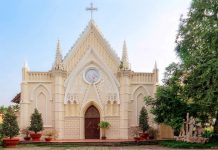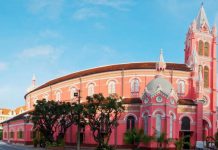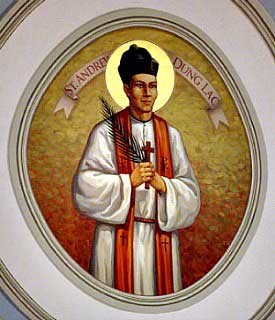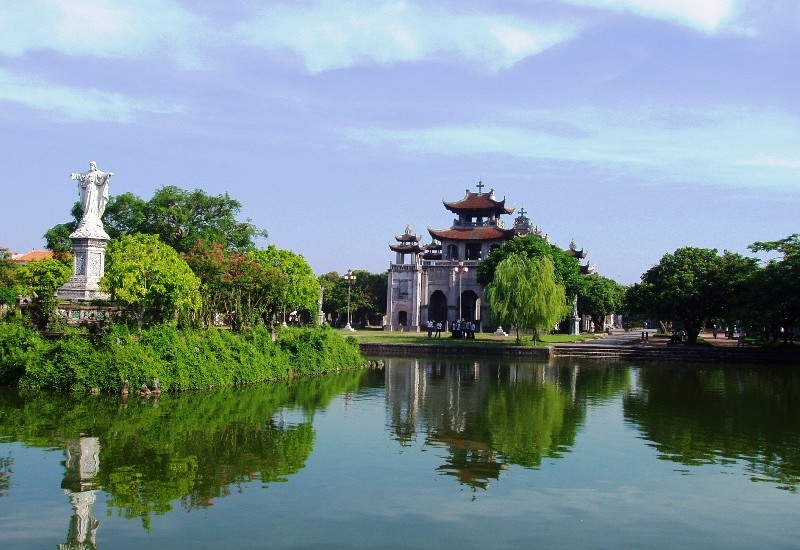Hanoi Cathedral or the Main Church of Hanoi, is an old church and was built in Hanoi by the French colonial government. The religious activities of Hanoi parishioners under The Archdiocese of Hanoi often take place in here.
1. Location
The church is now located at No.40 Nha Chung Street, Hoan Kiem District, Hanoi, a large area, adjacent to the Archdiocese’s Building of Hanoi, Hanoi Seminary. The distance from Hanoi cathedral to Noi Bai International airport is 25 km, 41 minutes by car,
2. History of Hanoi Catheral
In 1873, when the French conquered the Hanoi forlification for the first time, The Bishop of Diocese of West North (old) P.F. Puginier (Vietnamese name is Phuoc), with the consent of the then Province Chief of Hanoi, Nguyen Huu Do, occupied an area at the head of Bao Thien Tu village (Bao Thien pagoda) under Tho Xuong district (old) and built a wooden church here. Many sources of history, as the book La vie de Mgr. Puginier by Louvet, the documents in the Archives of Foreign Process server Association in Paris (MEP), said the land inside Hanoi Cathedral and Nha Chung Street area today, which originally belonged to the Báo Thiên tự (Bao Thien tower pagoda) built in the Lý dynasty. This was the famous national pagoda of Great Vietnamese capital during the reigns of Lý – Trần – Hồ (the 16th – 17th century). During the Lê – Nguyễn dynasty (15th – 18th century), this remained an important spiritual locations, where the Buddhist rituals took place to pray for national peace and security. Going through time and wars,Tower of Bao Thien pagoda no longer existed, only Bao Thien pagoda left. By 1882, when the French conquered Hanoi capital city for the second time, Bishop Paul-Francois Puginier destroyed completely Bao Thien pagoda and built the church instead. The cost was estimated about 200,000 French francs, the Bishop suggested that the French government should raise fund by lottery. After being refused twice, he was finally approved to open two fits of the lottery (first fit in 1883, the second fit in 1886), that raised about 30,000 French francs, plus other funding sources, enough expense to complete the church in 1886.
A new church was built on the land of Bao Thien pagoda, then the gradual expansion of the church had turned most of the land of Bao Thien Pagoda into the church’s. The land of former Bao Thien pagoda included the whole current area of the Cathedral and Nha Chung street.
At first, the church called Church of St. Giuse (Saint Joseph) because in 1678, Pope Innocentius the 11th consecrated Joseph (foster father of Jesus) to the high position of the patron saint of Vietnam and neighboring countries. Therefore, the largest church in Hanoi was appointed as “Cathedral honoring Saint Joseph”. The inauguration ceremony was held right on the Christmas in Đinh Hợi lunar year (the year of the Pig 1887).
3. Architecture of Hanoi Cathedral
The church was designed by the medieval European architectural style namely Gothique, so prevalent in the twelfth century and the period of Renaissance culture in Europe. The church was built in the form of the Madonna Cathedral in Paris (France) with curved arches, wide, toward the sky. The main constructive materials of the church were terra-cotta bricks tiles, the walls were plastered with strengthening paper. The church has a length of 64.5m, width of 20.5m and the two bell towers of 31.5m high with the big and heavy stone pillars to the four corners. On the top is a stone cross.

In the church hall there is a large door and two small doors on either side of the tower. The doors and all the windows were rolling pointedly as the art of Gothique, combining with the paintings of Saint made of beautiful and harmonious color glass to create natural light source inside the church. Saint sanctuary was decorated by traditional folk art, carved patterns by red lacquer trimmed with gold wood sophisticatedly and uniquely painted yellow card son. At the main space there is the over 2-meter statue of Saint Joseph made from terra-cotta.
The church has a set of French bells, including four small bells and a bell large deck, worth 20,000 French francs at the time. In particular, a large clock was mounted between the fronts of the church. The clocks have the alarm of quarter of an hour, alarming; the system of alarming bells was associated with five bells hanging on the two towers.
The square center in front of the church has the metal statue of Madonna. Around the church, there is palanquin path, parterres; behind there is a stone cave.
Currently, due to the development of the urbanization process, space and landscape of the church were crowded, doped, losing the match with the huge scale of the church.
Hanoi Cathedral is the main church of the Hanoi Archdiocese and one of the center of Catholic activities in Hanoi and surrounding areas. On weekdays, the church has two Masses, Sunday has 7 Masses. In addition, the church also celebrates the Mass to pick up Joseph Saint Sponsor of the Archdiocese in Ha Noi on the March 19th every year.















